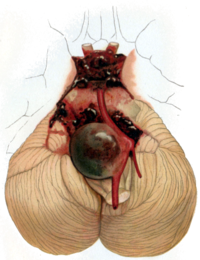
Photo from wikipedia
OBJECTIVE Thin-walled regions (TIWRs) within cerebral aneurysms have a high risk of rupture during surgical manipulation. Previous reports have demonstrated specific changes in the parameters of computational fluid dynamics in… Click to show full abstract
OBJECTIVE Thin-walled regions (TIWRs) within cerebral aneurysms have a high risk of rupture during surgical manipulation. Previous reports have demonstrated specific changes in the parameters of computational fluid dynamics in TIWRs; however, they have not been fully evaluated. We identified and investigated a novel parameter, wall shear stress vector cycle variation (WSSVV), with user-friendly software that could predict TIWRs. METHODS Twelve unruptured cerebral aneurysms were analyzed. TIWRs were defined as reddish areas compared with the normal-colored parent artery on intraoperative views. The position and orientation of these clinical images were adjusted to match the WSSVV color maps. TIWRs and thick-walled regions (TKWRs) were marked and compared with the corresponding regions on WSSVV maps. The default images obtained from WSSVV imaging required appropriate maximum color bar value (MCBV) adjustment for predicting TIWRs. Sensitivity and specificity analyses were performed by changing the MCBV from 300 to 700 at intervals of 100. With the optimal MCBV, the WSSVV values were quantitatively compared. RESULTS All of the selected 18 TIWRs and 16 TKWRs corresponded to low- and high-value regions of the WSSVV color maps at the adjusted MCBV, respectively. The mean optimal MCBV was 483.3 ± 167.50 (range, 300-700). According to receiver operating characteristic analysis, the best MCBV for predicting TIWRs was 500 (highest sensitivity, 0.89; specificity, 0.94). Under this condition, the quantitative values of the computational fluid dynamics color maps for TIWRs and TKWRs were significantly different (P < 0.01). CONCLUSIONS Low WSSVV values may indicate TIWRs within cerebral aneurysms.
Journal Title: World neurosurgery
Year Published: 2019
Link to full text (if available)
Share on Social Media: Sign Up to like & get
recommendations!